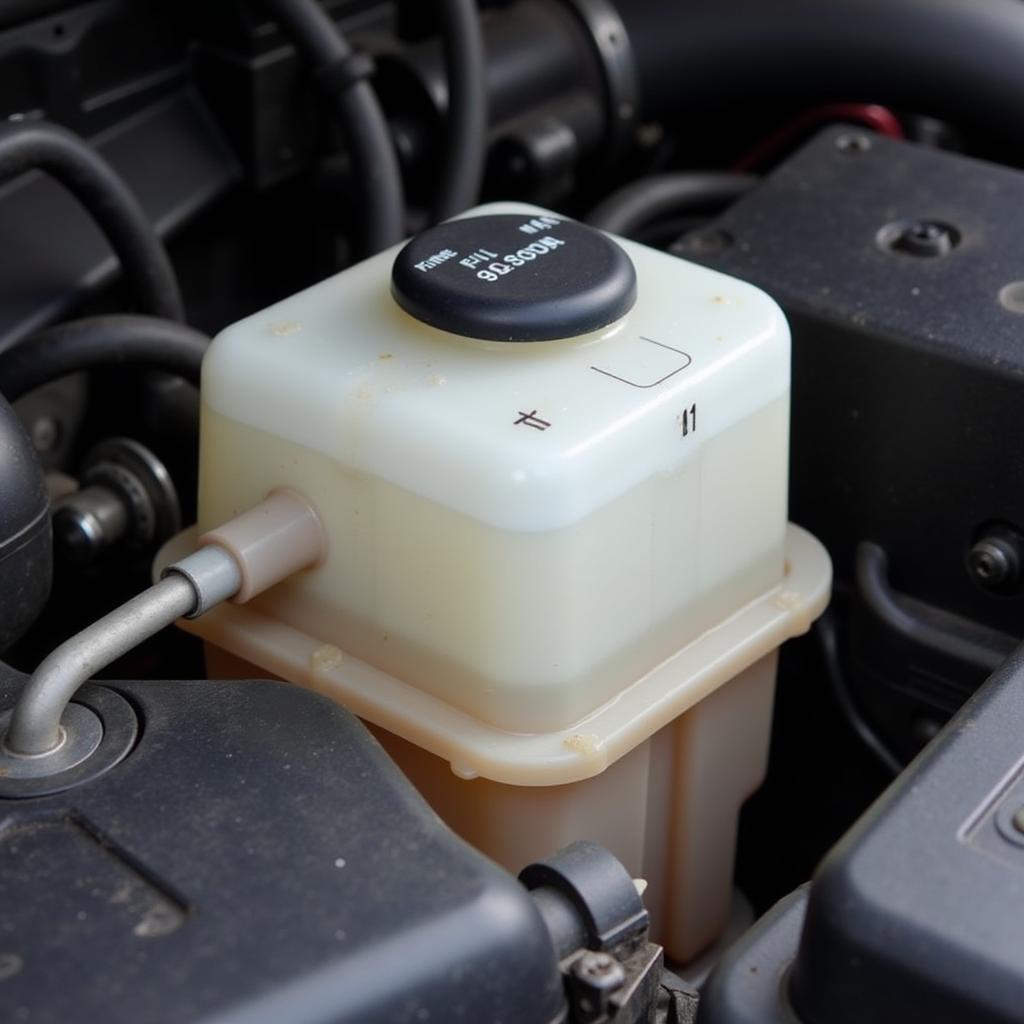The Mercedes brake pad warning light is a crucial indicator that your vehicle’s brakes need attention. When this light illuminates on your dashboard, it’s essential to address the issue promptly. This article will delve into the common causes behind the Mercedes brake pad warning light, guide you through effective troubleshooting techniques, and explain how to reset the light.
Understanding the Mercedes Brake Pad Warning Light
The Mercedes brake pad warning light is designed to alert the driver when the brake pads have worn down to a critical level. This light typically illuminates when the brake pads have reached approximately 10% of their original thickness. The system uses sensors embedded in the brake pads to detect this wear.
What Does the Mercedes Brake Pad Warning Light Look Like?
The brake pad warning light on a Mercedes typically resembles a triangle with an exclamation mark inside it. The light may also be accompanied by a specific warning message on the dashboard, providing more detailed information.
Common Causes of the Mercedes Brake Pad Warning Light
Several factors can trigger the brake pad warning light on your Mercedes. Here are the most common causes:
- Worn Brake Pads: The most common reason for the brake pad warning light is simply that the brake pads are worn down to their minimum thickness. This is a normal part of the brake pad’s lifecycle and requires replacement.
- Faulty Brake Pad Wear Sensor: The sensor embedded in the brake pad can malfunction, sending an inaccurate signal to the vehicle’s computer. This can cause the warning light to illuminate even if the brake pads are still in good condition.
- Electrical Malfunction: Occasionally, a wiring problem or a faulty electrical connection in the brake system can trigger the warning light. This is less common but can occur.
How to Troubleshoot the Mercedes Brake Pad Warning Light
Here’s a step-by-step guide to troubleshoot the Mercedes brake pad warning light:
- Visually Inspect the Brake Pads: First, locate the brake pads on your vehicle. With the wheels off, you can visually inspect the brake pads and measure their thickness. If the pads are visibly worn or have less than 3 mm of thickness remaining, they require replacement.
- Check the Brake Pad Wear Sensor: The wear sensor is typically located on the brake pad or in the caliper. Examine the sensor for any damage or signs of a loose connection. If the sensor is damaged, it needs to be replaced.
- Inspect the Brake System: Check for any signs of leaks, loose connections, or other issues that may indicate a faulty brake system component. It’s advisable to have your brake system inspected by a qualified mechanic if you suspect a more significant problem.
Resetting the Mercedes Brake Pad Warning Light
Once you have replaced the brake pads and ensured all components are working correctly, you need to reset the brake pad warning light. This process varies depending on the model year and Mercedes model.
mercedes a class brake pad warning light reset
Here’s a general guideline for resetting the brake pad warning light:
- Start the Engine: Turn on your Mercedes and allow the engine to idle for a few minutes.
- Access the Vehicle’s Menu: Use the steering wheel controls or the touchscreen display to navigate to the vehicle’s menu.
- Locate the Brake Pad Reset Option: The brake pad reset option may be located within the “Vehicle Settings,” “Maintenance,” or “Service” menus.
- Select the Reset Option: Follow the on-screen instructions to confirm the brake pad reset.
- Confirm Reset: The brake pad warning light should now be reset and extinguished.
Preventing Brake Pad Warning Light Issues
Here are some tips to help you avoid future brake pad warning light issues:
- Regular Brake Inspections: Have your brake pads inspected regularly by a qualified mechanic. This is typically recommended at every oil change or at least every 12 months.
- Use High-Quality Brake Pads: Opt for high-quality brake pads from reputable manufacturers.
- Avoid Aggressive Driving: Excessive braking and harsh acceleration can accelerate brake pad wear.
- Maintain Proper Brake Fluid Levels: Low brake fluid levels can affect brake performance and trigger the warning light.
Expert Insights
“If you’re unsure about your Mercedes brake pad warning light, always consult a certified mechanic. They can diagnose the issue accurately and recommend the appropriate solution.” – [Name of Expert], [Title]
“Don’t ignore the brake pad warning light. Driving with worn brake pads is dangerous and can lead to serious accidents. Address the issue promptly to ensure the safety of yourself and others on the road.” – [Name of Expert], [Title]
FAQs
Q: How often should I change my brake pads?
A: Mercedes brake pad replacement intervals vary depending on driving habits and conditions. On average, you can expect to replace your brake pads every 25,000 to 50,000 miles.
Q: Can I reset the brake pad warning light without replacing the pads?
A: Resetting the brake pad warning light without replacing the pads is not recommended. The light is an indication of worn brake pads, and ignoring it can lead to safety issues.
Q: What are the signs of worn brake pads?
A: In addition to the warning light, signs of worn brake pads include squeaking or grinding noises when braking, a spongy brake pedal, and increased stopping distance.
Q: How much does it cost to replace brake pads on a Mercedes?
A: The cost of brake pad replacement varies depending on the Mercedes model, labor costs, and the type of brake pads used. It’s best to contact your local Mercedes dealership or an independent repair shop for an accurate estimate.
Q: Can I replace the brake pads myself?
A: While some individuals are comfortable performing brake pad replacement themselves, it’s a complex procedure requiring specialized tools and knowledge. If you’re not confident in your abilities, it’s recommended to seek professional assistance.

